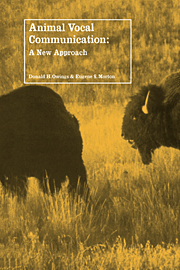Book contents
- Frontmatter
- Contents
- Preface
- Acknowledgments
- Prologue
- 1 Overview of ideas
- 2 The roles of assessment and management in communication
- 3 Form and function in vocal communication
- 4 Mechanisms and proximate processes of vocal communication
- 5 Assessment/management: a viable replacement for the information concept
- Reference
- Index
Prologue
Published online by Cambridge University Press: 05 June 2012
- Frontmatter
- Contents
- Preface
- Acknowledgments
- Prologue
- 1 Overview of ideas
- 2 The roles of assessment and management in communication
- 3 Form and function in vocal communication
- 4 Mechanisms and proximate processes of vocal communication
- 5 Assessment/management: a viable replacement for the information concept
- Reference
- Index
Summary
Carolina wren
A male Carolina wren was widowed in the flash of a sharp-shinned hawk's attack. It was late September, but singing and pairbonding are possible throughout the year for this wren, as is the case with tropical-living birds, even though the hawk struck in the State of Maryland, USA. The widowed male continued to sing and otherwise defend his permanent year-round territory using a repertoire of 42 song types. He sang one type 5 to 120 times before switching to another. During the two months after he became independent from his parents, his song-learning phase, he had learned 85% of his song types from neighboring males; he learned the remaining 15% while dispersing or from males more distant from his territory and not found in his neighbors' repertoires. At 9:00 a.m. a stranger wren was detected. The male approached it with plumage fluffed, quickly sang three song types without the usual pause between them, then attacked. The intruder gave high-pitched pi-zeet calls, an appeasement or friendly call between mates or siblings. It then gave high pee pee pee calls as the resident male continued to attack, producing short growls during each attack flight. Between attacks, the resident male also uttered harsh, low chirrs between attacks. The intruder fled silently. At 10:30 a.m. a second intruder was detected.
- Type
- Chapter
- Information
- Animal Vocal CommunicationA New Approach, pp. 1 - 12Publisher: Cambridge University PressPrint publication year: 1998



